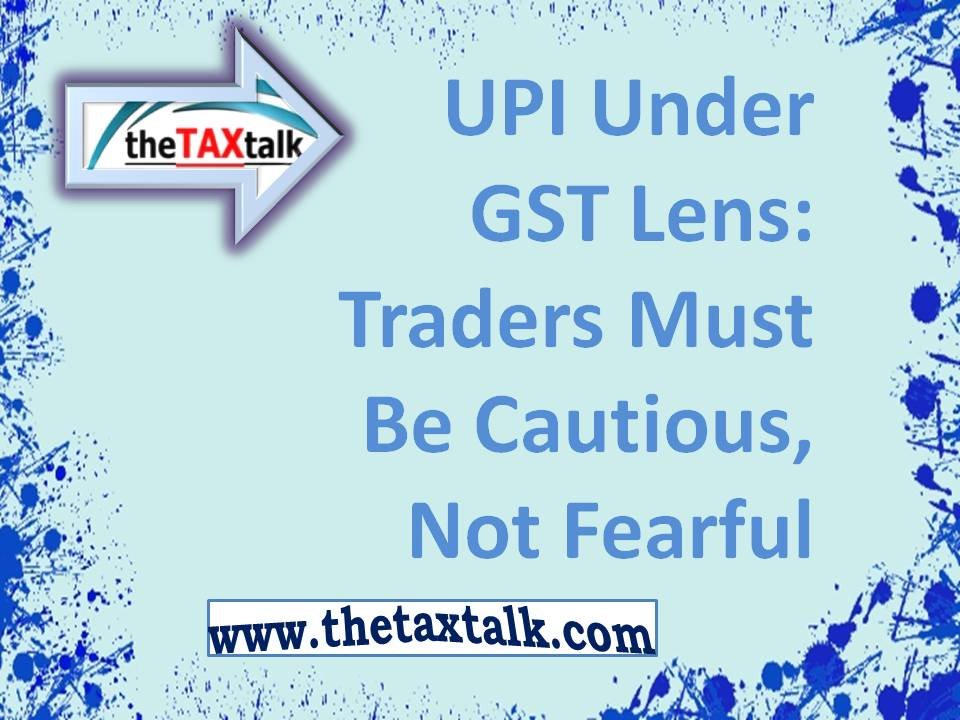![]()
UPI Under GST Lens: Traders Must Be Cautious, Not Fearful
Digital Convenience Doesn’t Mean Tax Immunity – Here’s What Every Small Business Must Know
Unified Payments Interface (UPI) has revolutionized the way India transacts—fast, cashless, and efficient. But in the eyes of the tax department, every digital trail could be a tax trail. As over 13,000 traders recently discovered, even small UPI transactions can now invite scrutiny under the Goods and Services Tax (GST) regime. If you’re a small business owner, composition dealer, or freelancer relying heavily on UPI, it’s time to understand the tax implications—before panic sets in.
1. UPI ≠ Tax-Free
Let’s bust the biggest myth right away: just because money is transferred digitally doesn’t mean it’s invisible to the tax authorities. A ₹20 tea payment on Google Pay may seem insignificant, but if such payments form a pattern linked to your business activity, they can raise red flags. GST notices have been triggered by even small UPI transactions, especially when they’re frequent or involve customer payments.
Lesson: Digital doesn’t mean undocumented. Every UPI payment creates a digital footprint that can be matched against your tax filings.
2. GST Scrutiny Is Real
The department’s recent move of sending notices to over 13,000 small traders based solely on their UPI transaction volumes shows the intensity of AI-driven scrutiny. These notices are not random—they’re based on mismatches between reported GST turnover and actual inflows seen through payment gateways like PhonePe, GPay, and Paytm.
Takeaway: UPI trail = Tax trail. If your business isn’t declaring these receipts properly, you may receive a call for explanation—or worse, a tax demand.
3. Not Every UPI Is a Sale
Here lies the nuance that’s often missed in automated scrutiny. UPI transfers can happen for a variety of reasons—loan repayments from relatives, tuition fees, exempt goods, reimbursement of expenses, etc. Not every credit in your bank account means income or a taxable supply under GST.
Action Point: If you receive a notice, don’t panic. Clarify the nature of each transaction before accepting any tax liability. Documentation matters more than ever.
4. Composition Dealers Under Pressure
Composition scheme dealers, who pay GST at a lower fixed rate with no ITC benefit, are facing unexpected challenges. Officials are asking questions like, “If you’re receiving ₹20,000/month via UPI, how can your annual turnover be under ₹75 lakh?”
This is a flawed assumption. UPI volume includes many non-taxable or non-business receipts, and should not be equated with GST turnover.
Important: UPI inflows ≠ taxable sales. Dealers should maintain clear records showing the nature of each receipt to defend their composition status.
5. Solution = Clarity, Not Panic
The current situation has created anxiety among small traders, especially in Tier-II and Tier-III cities. What’s needed is not fear, but clarification—both from the government and from tax professionals. There must be clear guidelines on:
• How UPI receipts are to be treated under GST
• Differentiation between business and personal transactions
• Treatment of exempt or non-GST income received via digital modes
In the broader vision of Digital India, trust and transparency are the cornerstones. UPI is an enabler, not a threat—but only if both the system and its users are educated and prepared.
Final Word:
For traders, freelancers, tuition classes, or small retailers—UPI brings convenience, but also responsibility. Keep your books updated, your documentation ready, and your intent honest. For the government, a balanced approach with clear instructions can ensure digital growth without digital distress.


